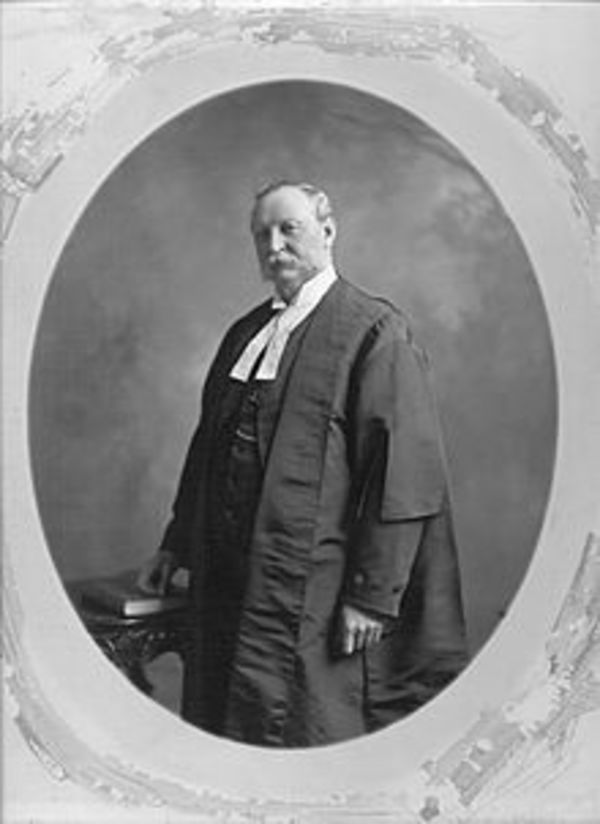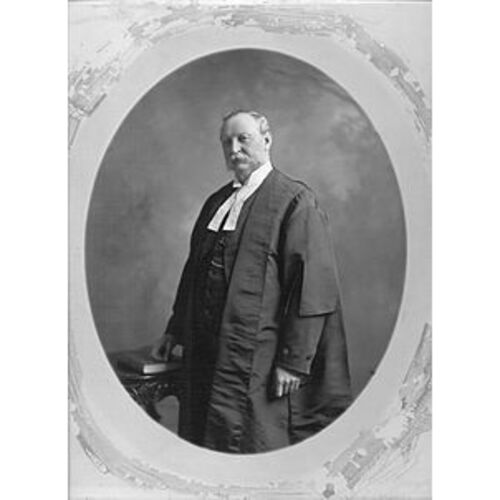
Source: Courtesy of Wikimedia Commons
MOSS, Sir CHARLES, lawyer and judge; b. 8 March 1840 in Cobourg, Upper Canada, son of John Moss, a brewer, and Ann Quigley; m. 26 Sept. 1871 Emily Sullivan (d. 1941) in Toronto, and they had six daughters and three sons; d. there 11 Oct. 1912.
The third son of Irish Catholic parents – his father came from near Maryborough (Portlaoise, Republic of Ireland), his mother was from Belfast – Charles Moss was educated in Cobourg’s public schools and at John Boyd’s academy in Toronto. His family moved to the city in 1846 when his father acquired a brewery. Charles worked for a time in this business and then embarked on a legal career.
Admitted to the Law Society of Upper Canada on 29 Nov. 1864, he was articled to his brother Thomas* and proved to be a brilliant student, receiving four scholarships from the society. In 1866 he produced, with his future brother-in-law Robert Sullivan, A handy book of commercial law for Upper Canada (Toronto). Moss was called to the bar on 4 Dec. 1869. Like Thomas, he moved easily into Toronto’s legal community and society. In 1871 he formed a partnership with his brother, Featherston Osler, and William Alexander Foster*; that same year, at St Luke’s Anglican Church, he was married by the Reverend Henry Scadding* to Emily, a daughter of the late judge Robert Baldwin Sullivan* and sister of Thomas’s wife. First elected a bencher of the law society on 3 Dec. 1880, Moss was named a qc on 13 Aug. 1881 by Governor General Lord Lorne [Campbell]; in 1891–92 he would serve as president of the York County Law Association.
The Moss firm became a source for Ontario’s expanding bench and the partners changed with each judicial appointment. In 1884, three years after Thomas’s death, it was constituted as a joint firm, Moss, Falconbridge, and Barwick, and Moss, Hoyles, and Aylesworth, with Charles Moss at the head. His partners included William Glenholme Falconbridge, who had married another of the Sullivan sisters. By the mid 1880s Moss had earned a solid reputation. According to one commentator, he possessed “that insight which becomes a quick solvent of difficulties, the clear, logical method of pursuing a sophistry to its last ditch, and the power to gather up fragments of argument and present them as a telling unit.” Among his important cases, all appeals, were the rivers and streams case (McLaren v. Caldwell, 1880–81), the St James’ rectory case (Langtry v. Dumoulin, 1884), and the assignments case (In re Assignments and Preferences Act, section 9, 1893).
Moss’s reputation extended into the field of legal education in Ontario. In 1872 he had been appointed to lecture on equity in the law society’s new school at Osgoode Hall; four years later he was made president and lecturer on common and commercial law. He continued as a teacher and examiner until the school closed in 1878. When, in 1889, the society decided to reopen it, he was instrumental in having its new curriculum, and the exemption of students from office duties during teaching terms, accepted by his professional colleagues. With the school’s principal, William Albert Reeve*, and fellow bencher Edward Martin he surveyed law schools in the United States in the summer of 1889. In addition, he was appointed chair of the law society’s legal education committee, with the responsibility of overseeing Reeve’s curriculum. That same year, when the University of Toronto established a law school, he was made an honorary lecturer on equity.
Moss, in fact, had been involved in the affairs of the university for some years: he had first been appointed to its senate as a representative of the law society in May 1884. On 10 March 1900 he succeeded William Mulock* as vice-chancellor and on 30 June the university granted him an honorary lld. In 1905 he was a member of the senate committee and the provincial royal commission formed to investigate the presidency of his friend James Loudon. A second royal commission resulted in the reorganization of the university, the abolition of the vice-chancellorship, and the institution, in June 1906, of the university act. Moss was appointed to the university’s new board of governors, where he would serve as vice-chairman. His term was renewed in June 1912. Despite Moss’s interest in bowling and croquet and his membership in the Royal Canadian Yacht Club, a close associate said that, apart from family, the university occupied most of his leisure time.
In politics Moss was a Liberal. Approached to contest Toronto East in a provincial by-election in 1878, he declined; in 1894 he ran unsuccessfully in Toronto South for the provincial legislature. But with the Liberals in power in Ontario and, from 1896, in Ottawa, his Liberal affiliations no doubt helped his career. On the instigation of justice minister Sir Oliver Mowat*, he was named a puisne judge of the Ontario Court of Appeal on 24 April 1897. After only five years, he became chief justice on 21 Nov. 1902, an appointment Moss attributed to Prime Minister Sir Wilfrid Laurier, who responded that he had simply given “expression to the wish of the community and especially of the bar.” In 1903 Moss refused a seat on the Supreme Court of Canada. As chief justice, he periodically acted as administrator of the province, and on 9 Nov. 1907 he was made a knight bachelor. Some of Moss’s decisions as chief justice received much publicity, such as that of 1909 on appeal in the Florence Mining Company case, which involved mining claims at Cobalt Lake and issues of provincial-federal jurisdiction. Throughout his time on the bench, however, he would be known more for his “extreme and painstaking care,” as judge William Renwick Riddell* put it, than for judicial brilliance.
A Roman Catholic who had evidently become an Anglican at the time of his marriage, Moss subsequently served as a director of Bishop Ridley College in St Catharines, Ont., and in the 1890s as vice-president and president of Havergal Ladies’ College in Toronto. Within his family, he had become the paterfamilias after the death in 1882 of his remaining brother, William, a Winnipeg journalist. His wife, a dedicated volunteer and lifelong member of St James’ Cathedral, was active in the Woman’s Auxiliary of the Church of England, served as first president of the Women’s Canadian Club in Toronto, and in the early 1890s founded the Crèche, a nursing institute for children.
Sir Charles Moss developed cancer in 1910 and took leave from his judicial duties in January 1912 after being thrown from his carriage. Ill health prevented his return and, despite a recuperative trip to Britain, he died at his Jarvis Street home, Roseneath, on 11 October. During his funeral at St James’ on the afternoon of the 14th, classes at the university and legal business at both city hall and Osgoode Hall were cancelled in testimony to his contributions.
AO, F 775, MU 2134, 1934, no.4; F 1029; RG 22-305, no.26306; RG 80-8-0-433, no.6158. NA, MG 26, G: 69029–31, 69099; RG 31, C1, 1871, Toronto, St James’ Ward, div.4: 69–70. Evening Telegram (Toronto), 22, 24 March 1941. Globe, 27 Sept. 1871; 9 Nov. 1907; 12, 15 Oct. 1912. Globe and Mail, 22, 25 March 1941. News (Toronto), 12 Oct. 1912. Toronto Daily Star, 14 Oct. 1912, 19 Jan. 1917, 24 June 1939. World (Toronto), 10 March 1900, 12 Oct. 1912, 26 Oct. 1916. G. B. Baker, “Legal education in Upper Canada, 1785–1889: the Law Society as educator,” in Essays in the history of Canadian law . . . , ed. D. H. Flaherty et al. (7v. to date, Toronto, 1981– ), 2: 48–142. Canada Gazette, 1 May 1897, 22 Nov. 1902. Canada Law Journal (Toronto), 5 (1865): 1 ; 17 (1881): 21; 33 (1897): 413–15; 48 (1912): 597–99. Canadian annual rev. (Hopkins), 1902–11. Canadian men and women of the time (Morgan; 1898). Canadian who’s who (1910). Cyclopædia of Canadian biog. (Rose and Charlesworth), 1: 386–87. Directory, Toronto, 1882–1912. W. J. Loudon, Sir William Mulock: a short biography (Toronto, 1932). Nelles, Politics of development. W. R. Riddell, The legal profession in Upper Canada in its early periods (Toronto, 1916). W. S. Wallace, A history of the University of Toronto, 1827–1927 (Toronto, 1927).
Cite This Article
Alexander Reford, “MOSS, Sir CHARLES,” in Dictionary of Canadian Biography, vol. 14, University of Toronto/Université Laval, 2003–, accessed December 31, 2025, https://www.biographi.ca/en/bio/moss_charles_14E.html.
The citation above shows the format for footnotes and endnotes according to the Chicago manual of style (16th edition). Information to be used in other citation formats:
| Permalink: | https://www.biographi.ca/en/bio/moss_charles_14E.html |
| Author of Article: | Alexander Reford |
| Title of Article: | MOSS, Sir CHARLES |
| Publication Name: | Dictionary of Canadian Biography, vol. 14 |
| Publisher: | University of Toronto/Université Laval |
| Year of publication: | 1998 |
| Year of revision: | 1998 |
| Access Date: | December 31, 2025 |



